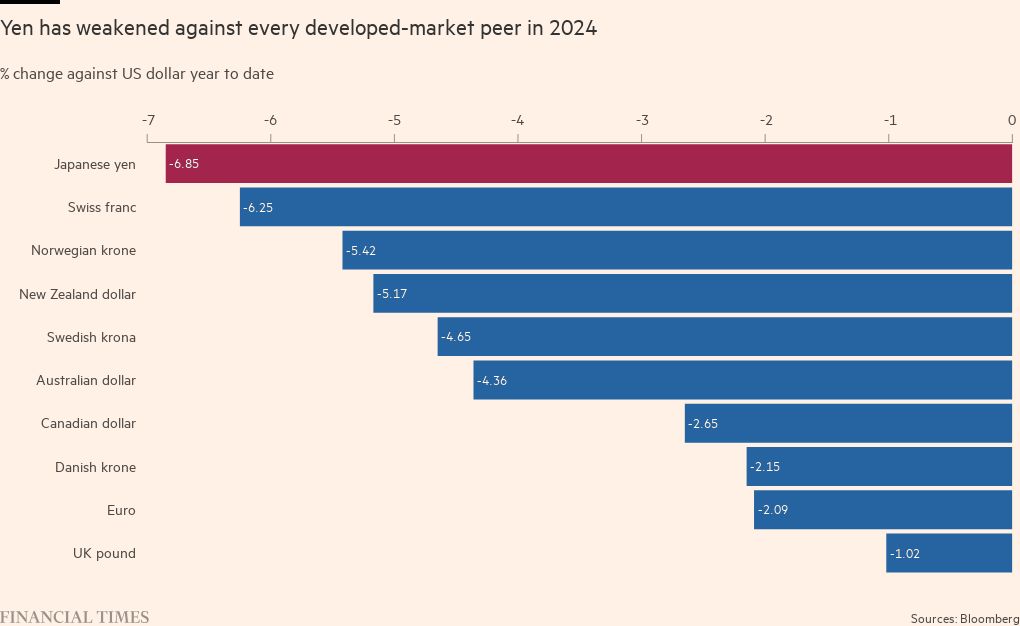Making sense of a wrong-way bet on the yen

Roula Khalaf, Editor of the FT, selects her favourite stories in this weekly newsletter.
The writer is a former chief investment strategist at Bridgewater Associates
Just three months ago, many in the analyst community expected that 2024 would mark an inflection point for the yen after three years of the currency falling against the dollar. The consensus forecast was for the yen to appreciate from ¥141 against the US currency at the end of 2023 to ¥135 a year later, according to Bloomberg data.
Instead, however, the yen has fallen further, flirting with levels near ¥152. Among the largest developed-market currencies, the yen has lost the most against the dollar so far this year, weakening nearly 7 per cent.
So what went wrong with the forecasts? Some yen support was expected from structural factors including a significant current-account surplus and attractive valuations (the yen is near record lows against a trade-weighted basket of currencies).
However, the catalyst in focus was Japanese monetary policy. Specifically, the potential for Japanese reflation to warrant higher interest rates for the first time since 2007 was seen as a key source of yen strength. Currencies tend to be heavily influenced by the relative attractiveness of their interest rates.
Fast forward to late March. The Bank of Japan delivered, even more than expected. In one fell swoop it ended negative interest rates, purchases on exchange traded funds and its programme of capping government bond yields. But the yen call — at least so far — provides a timely reminder that getting exchange rates right means more than understanding dynamics within a country. What happens between countries in the currency pair that’s being examined, as well as global conditions, can matter as much and often more. In the case of the yen, the biggest miss wasn’t something occurring in Japan but rather in the US and globally.
Most importantly, bullish yen forecasters assumed a repeat of the historical relationship between US economic conditions and monetary policy, without sufficiently considering what could be different this time. Late last year, analysts expected that the most aggressive monetary policy tightening cycle in four decades would result in slower US growth and continued disinflation, as it had over past business cycles. That in turn would lead to cuts in benchmark interest rate that would render the dollar less attractive. Futures trading at the start of 2024 signalled expectations of about 1.5 percentage points of such cuts, potentially starting in March.
At the latest Federal Reserve policy meeting though rates were held steady. And while the Fed’s so-called dot plot of policymaker projections still pencilled in three 25 basis point cuts this year, Fed chair Jay Powell emphasised a continued cautious approach.
In hindsight, it’s easy to see why extrapolating from past cycles didn’t work. With strong private sector balance sheets going into the Fed tightening cycle, a robust job market and healthy consumers, the impact of rising interest rates was severely blunted.
The US macro environment has influenced the yen in another way too. With relatively low Japanese yields, the yen is frequently used as a funding currency. That means investors borrow yen to buy higher-yielding currencies and other assets. This in turn puts pressure on the yen when it is sold to carry out such purchases. These so-called carry trades historically have worked best in periods of healthy US and global growth and macro calm, when exchange rates tend to be less volatile.
At the start of 2024, there was substantial angst among economists and analysts about the global macro outlook. That consensus thinking likely translated into a belief that 2024 would be less conducive for carry trades, with slower growth and greater uncertainty. Less interest in using funding currencies, in turn, nudged forecasters towards relatively stronger yen views. For now, though, there is little evidence that global geopolitical risk is materially weighing on economic growth or markets.
Not surprisingly, yen funding has remained popular. The Japanese currency has depreciated year to date against not just the dollar but every developed-market peer, according to Bloomberg data.
Maybe currency forecasters will still be proven right in the direction of the yen this year; maybe the big inflection point has just been delayed. Most likely, though, being right on the Japanese currency will not be about Japan but rather what happens in the US and with global investor sentiment. Even then, and especially after the misses of recent years, analysts should keep questioning how the world is evolving and how those changes might make historical patterns and their current assumptions wrong.

Comments